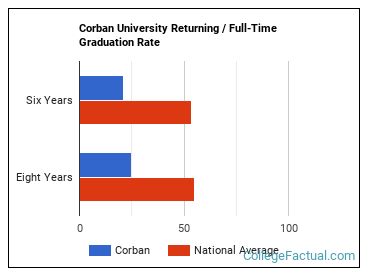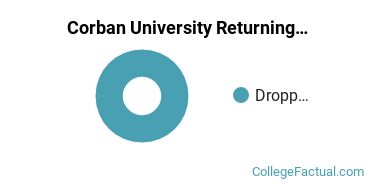 by our College Data Analytics Team
by our College Data Analytics TeamMake an informed decision about your education by understanding Corban retention and graduation rates. First year retention rates let you know how many first-time, full-time students students come back for their second year. Graduation rates tell you how many students complete their degree and how long it takes.
Freshmen retention rate refers to the percentage of first-time / full-time students who return for their second year.
With 79% students making it past their freshmen year, Corban has freshmen retention rates above the national average.
Nationwide, the average first to second year retention rate is 70.57%.
When looking at just colleges and universities in Oregon, the average is 67.48%.

| Retention Rate | |
|---|---|
| Corban | 79% |
| Nationwide | 70.57% |
| Oregon | 67.48% |
Of the 158 students in the class of 2015, how many completed their degree on time?
41% of the cohort completed their degree in four years, 44% in six years, and 45% in eight years.
The official graduation rate of Corban is 44%. This is the percentage of students who completed their degree within 150% of the published time. That means six years for a standard bachelor's degree program.
How long does it take to get a bachelor's degree at Corban? The standard length of time for most students is 4.09 years.


| Completion Within | Undergraduates | Percentage |
|---|---|---|
| Four Years | 127 | 35% |
| Six Years | 158 | 44% |
| Eight Years | 3 | 1% |
| Did Not Complete | 199 | 55% |
Approximately 199 students or 55% of the cohort did not complete their degree within eight years.
What happened to the 199 students who did not complete their degree?
0 are still enrolled.
60 transferred to another institution.
Corban lost contact with the remaining 139 who we assumed dropped out.

| Non-Completions | Undergraduates | Percentage |
|---|---|---|
| Still Enrolled | 0 | 0.0% |
| Transferred | 60 | 30.2% |
| Dropped Out | 139 | 69.8% |
Some schools have mainly first-time, full-time students, while others cater to part-time students, transfer students, or adult learners. For a variety of reasons first-time, full-time students under the age of 25 are usually more likely to graduate in four years.
Traditional Students:
First-time, full-time students under the age of 25.
Non-Traditional Students:
Any student that is not first-time, full-time, and under the age of 25.
The majority of students at Corban are considered 'traditional students' who are first-time attending full-time.
Comparing the graduation rates of specific cohorts shown below will be more revealing than the overall statistics shared above.
First-time / full-time students at Corban University represent 78% of the students in the class of 2015, and 89.87% of Corban bachelor's degree graduations.
With a four-year graduation rate of 41%, first-time students in the Corban class of 2015 who attended classes full-time were more likely than average to graduate on time.
After six years, the Corban graduation rate was 51%, and by the eight year mark, 51% of the cohort had completed their degree.
Nationwide, the average graduation rate for first-time undergraduates attending classes full-time is 37.92% after four years, 46.43% after six years, and 47.82% after eight years.

| First-Time / Full-Time Completions | Corban | Nationwide |
|---|---|---|
| Four Years | 41% | 37.92% |
| Six Years | 51% | 46.43% |
| Eight Years | 51% | 47.82% |
139 first-time / full-time students or 49% did not complete their degree within eight years.
Of those who did not finish:
0 are still enrolled.
52 transferred to another institution.
Corban lost contact with the remaining 87 who we assumed dropped out.

| First-Time / Full-Time Non-Completions | Undergraduates | Percentage |
|---|---|---|
| Still Enrolled | 0 | 0.00% |
| Transferred | 52 | 37.41% |
| Dropped Out | 87 | 62.59% |
Unfortunately, we don’t have access to data on Corban first-time, part-time students.
76 Corban students were classified as full-time / not first-time. This represents 21.11% of the students in the class of 2015.
Non first-time students could include transfer students or adults who have returned to school after an absense.
With a six year graduation rate of 21%, returning students in the class of 2015 and attended classes full-time had a graduation rate lower than the national average for students in this category.
After eight years, the graduation rate was 25%.
Nationwide, the average graduation rate for non first-time undergraduates attending classes full-time is: 49.57% after four years, 53.83% after six years, and 55.07% after eight years.

| Returning / Full-Time Completions | Corban | Nationwide |
|---|---|---|
| Four Years | 0% | 49.57% |
| Six Years | 21% | 53.83% |
| Eight Years | 25% | 55.07% |
57 non first-time / part-time students or 75% did not complete their degree within eight years.
Of those who did not finish:
0 are still enrolled.
8 transferred to another institution.
Corban lost contact with the remaining 49 who we assumed dropped out.

| First-Time / Part-Time Non-Completions | Undergraduates | Percentage |
|---|---|---|
| Still Enrolled | 0 | 0.00% |
| Transferred | 8 | 14.04% |
| Dropped Out | 49 | 85.96% |
3 Corban students were classified as full-time / not first-time. This represents 0.83% of the students in the class of 2015.
With a six year graduation rate of 0%, returning students in the class of 2015 and attended classes full-time had a graduation rate lower than the national average.
After eight years, the graduation rate was 0%.
Nationwide, the average graduation rate for non first-time undergraduates attending classes part-time is: 36.03% after six years, 36.03% after eight years.
3 non first-time / part-time students or 100% did not complete their degree within eight years.
Of those who did not finish:
0 are still enrolled.
0 transferred to another institution.
Corban lost contact with the remaining 3 who we assumed dropped out.

| Returning / Part-Time Non-Completions | Undergraduates | Percentage |
|---|---|---|
| Still Enrolled | 0 | 0.00% |
| Transferred | 0 | 0.00% |
| Dropped Out | 3 | 100.00% |